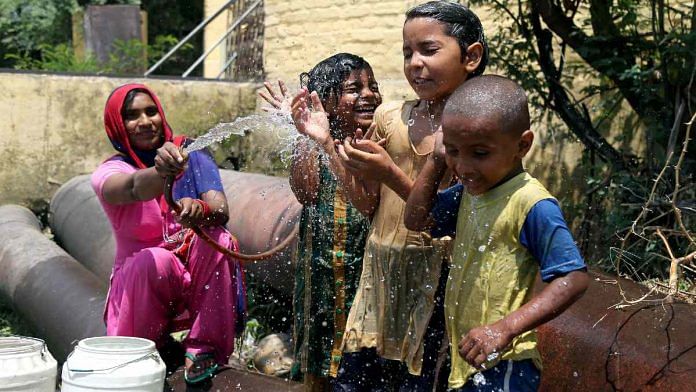Bengaluru: It was a prospect of hope in the early days of the Covid-19 pandemic, which is believed to have begun in China last December, as speculation suggested that the disease may disappear as temperatures rise with the arrival of summer.
The initial phase of the pandemic was also marked by much uncertainty about the role played by face masks in prevention, and how exactly the virus spreads.
Much of our early understanding of the virus has changed in light of deeper research and the growing incidence of the disease.
Here, ThePrint discusses four viral theories that took root amid the world’s first brush with the pandemic, and how they have panned out in the months since.
Also Read: ‘Coincidental, not causal’: Experts say Delhi’s Covid surge and peak summer are not linked
Effect of temperature and humidity on spread
Many people, including US President Donald Trump, stated that the virus would disappear by the summer as temperatures went up. Some observational studies on minimal, early data also claimed the virus showed a trend of lowered spread as temperatures or humidity climbed up.
However, this theory has been called into question by research performed on the virus, which suggests that temperature only seems to kill the virus when it reaches 70 degrees Celsius or above. This is one of the reasons why we know with reasonable certainty that the virus cannot persist in freshly cooked hot meals. The humidity link has also been refuted by experts, who point out that the hot and humid climes of countries like Singapore haven’t made them immune to the virus.
It’s also laid out by India’s experience, because the onslaught of coronavirus doesn’t seem to have weakened even as the country passes through peak summer months, including the hottest-ever May (tied with 2016, hottest throughout the world).
Also Read: Do masks help? Experts say even DIY masks are useful as Covid-19 is unrelenting
Innate immunity in India
Some experts claimed that Indians seemed to have an innate immunity against the virus, a theory that floated during the early days of the infection when the case numbers were low. Several factors were cited to back this claim — most Indians have received BCG shots, they have exposure to an extensive microbial load, and their food habits, which draw on spices with immunity-boosting properties.
This theory has not stood the test of time, with India now the fourth most-affected country in the world and accounting for the highest incidence in Asia.
Effectiveness of masking
One of the most contentious subjects has been the efficacy of masks.
In the early days of the pandemic, the World Health Organization (WHO) had said there wasn’t enough evidence to suggest healthy people should wear masks.
The discussion then evolved to state that many kinds of masks might not be completely efficient in holding back the virus, and unless the masks form a complete air-tight seal around the face, they will not prevent infection.
However, most agencies subsequently started reconsidering this position. India made masks mandatory as early as the first week of April.
Today, we know that any layer of protection works, when combined with physical distancing and regular hand-washing. Even homemade masks fashioned from t-shirts are enough, as the bottom line is keeping cough droplets in. The WHO updated its guidelines earlier this month to suggest the general public should wear masks in crowded places.
As the number of cases progresses, the amount of data scientists have increases. And data trends show that places that mandate masks seem to be curbing the spread of the virus better.
An important caveat is that masks are not completely effective by themselves, and need to be complemented with strict physical distancing and a rigorous sanitation routine.
Also Read: Covid-19 behaves like a sexually transmitted infection
Airborne transmission
The most polarising subject among experts has been whether the SARS-CoV-2 virus is airborne.
Health experts said at the start that the virus is transported only through cough droplets, and not aerosolisation from exhaled air. This meant to suggest that the virus could not spread from breathing the same air as an infected person. The WHO stated in March that there was not enough evidence to suggest that the virus is airborne.
However, experts in the field of airborne respiratory diseases and aerosols have stated that airborne transmission risk is very high. This theory has also been backed by research, including by a chemistry Nobel laureate. Research also suggests that wind currents can spread the virus, especially in indoor settings.
In a famous case reported from a Chinese restaurant, air currents from an air conditioner carried the virus from an infected person to those in the path of the air stream but not to those who weren’t, even if they were seated close to the new recipients of the virus.
Perhaps the biggest real-life test of masks and the lower possibility of airborne transmission outdoors came from an epidemiological study of large-scale gatherings in the US for the recent Black Lives Matter protests.
The study, which involved research on cases in 315 major US cities, of which 281 witnessed large demonstrations, showed no spike in new Covid cases in these cities because of the gatherings.
This lack of an explosion of cases has been attributed to the outdoor setting of the protests, as well as the fact that participants wore masks.
Also Read: Flushing toilets can create virus ‘cloud’, says study, raises concern on Covid-19 spread






